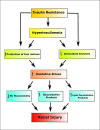Insulin Resistance and Type 2 Diabetes Mellitus: An Ultimatum to Renal Physiology
- PMID: 36111327
- PMCID: PMC9462660
- DOI: 10.7759/cureus.28944
Insulin Resistance and Type 2 Diabetes Mellitus: An Ultimatum to Renal Physiology
Abstract
Insulin resistance (IR) is stated as diminished insulin action regardless of hyperinsulinemia. The usual target organs for insulin activities are the liver, skeletal muscle, and adipose tissue. Hence, the vasculature and kidneys are nonconventional target organs as the impacts of insulin on these are comparatively separate from other conventional target organs. Vasodilation is achieved by raising endothelial nitric oxide (NO) generation by initiating the phosphoinositide 3-kinase (PI3K) pathway. In insulin-nonresponsive conditions, this process is defective, and there is increased production of endothelin-1 through the mitogen-activated protein kinase/extracellular signal-regulated kinase (MAPK/ERK) pathway, which predominates the NO effects, causing vasoconstriction. Renal tubular cells and podocytes have insulin receptors, and their purposeful importance has been studied, which discloses critical acts of insulin signaling in podocyte survivability and tubular action. Diabetic nephropathy (DN) is a prevalent problem in individuals with hypertension, poor glycemic management, hereditary susceptibility, or glomerular hyperfiltration. DN could be a significant contributing factor to end-stage renal disease (ESRD) that results from chronic kidney disease (CKD). IR and diabetes mellitus (DM) are the constituents of syndrome X and are accompanied by CKD progression. IR performs a key part in syndrome X leading to CKD. However, it is indistinct whether IR individually participates in enhancing the threat to CKD advancement rather than CKD complexity. CKD is an extensive public health problem affecting millions of individuals worldwide. The tremendous spread of kidney disease intensifies people's health impacts related to communicable and noncommunicable diseases. Chronic disease regulator policies do not include CKD at global, local, and/or general levels. Improved knowledge of the character of CKD-associated problems might aid in reforming diagnosis, prevention, and management.
Keywords: chronic kidney disease; diabetes mellitus; end-stage renal disease (esrd); insulin; insulin resistance; nitric oxide; pi3k pathway; podocytes; renal tubular cells; vasodilation.
Copyright © 2022, Sinha et al.
Conflict of interest statement
The authors have declared that no competing interests exist.
Figures





References
-
- Chronic kidney disease: a public health priority and harbinger of premature cardiovascular disease. Stenvinkel P. J Intern Med. 2010;268:456–467. - PubMed
-
- Oxidative stress in chronic kidney disease. Modaresi A, Nafar M, Sahraei Z. http://www.ijkd.org/index.php/ijkd/article/view/2044/766. Iran J Kidney Dis. 2015;9:165–179. - PubMed
-
- Insulin resistance in chronic kidney disease: new lessons from experimental models. Koppe L, Pelletier CC, Alix PM, Kalbacher E, Fouque D, Soulage CO, Guebre-Egziabher F. Nephrol Dial Transplant. 2014;29:1666–1674. - PubMed
-
- Diabetic nephropathy: an update on pathogenesis and drug development. A/L B Vasanth Rao VR, Tan SH, Candasamy M, Bhattamisra SK. Diabetes Metab Syndr. 2019;13:754–762. - PubMed
-
- Diabetes mellitus, a complex and heterogeneous disease, and the role of insulin resistance as a determinant of diabetic kidney disease. Karalliedde J, Gnudi L. Nephrol Dial Transplant. 2016;31:206–213. - PubMed
Publication types
LinkOut - more resources
Full Text Sources
Miscellaneous
